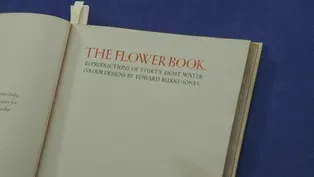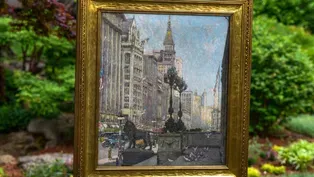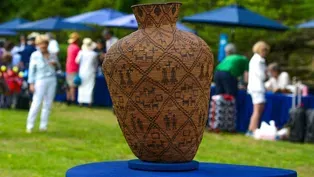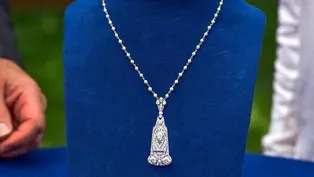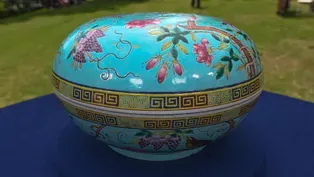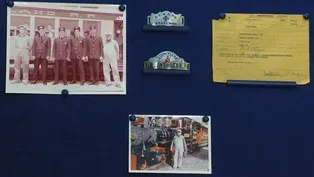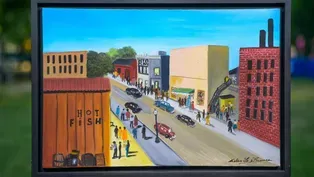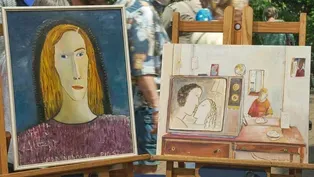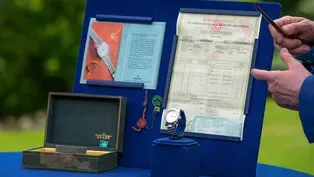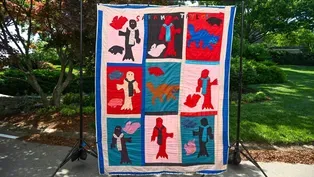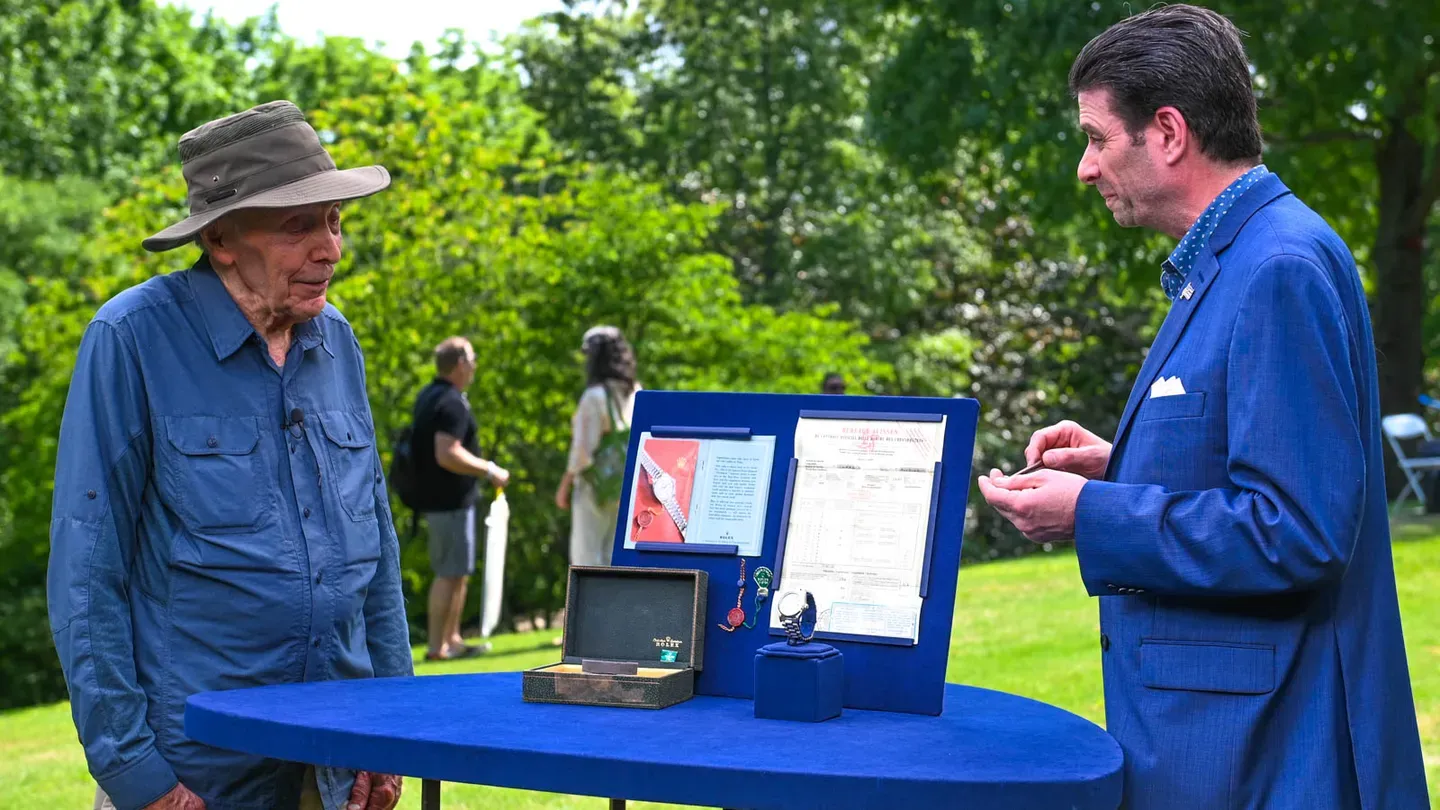

Cheekwood Estate & Gardens, Hour 2
Season 27 Episode 8 | 52m 27sVideo has Closed Captions
ROADSHOW visits Music City for an astonishing $75,000 to $85,000 find!
Visit Music City for astonishing finds including a Civil War Union soldier archive, Disneyland railroad hat badges, ca. 1957, and an art deco diamond, sapphire & pearl necklace, ca. 1925. One find is $75,000 to $85,000!
Problems with Closed Captions? Closed Captioning Feedback
Problems with Closed Captions? Closed Captioning Feedback
Funding for ANTIQUES ROADSHOW is provided by Ancestry and American Cruise Lines. Additional funding is provided by public television viewers.

Cheekwood Estate & Gardens, Hour 2
Season 27 Episode 8 | 52m 27sVideo has Closed Captions
Visit Music City for astonishing finds including a Civil War Union soldier archive, Disneyland railroad hat badges, ca. 1957, and an art deco diamond, sapphire & pearl necklace, ca. 1925. One find is $75,000 to $85,000!
Problems with Closed Captions? Closed Captioning Feedback
How to Watch Antiques Roadshow
Antiques Roadshow is available to stream on pbs.org and the free PBS App, available on iPhone, Apple TV, Android TV, Android smartphones, Amazon Fire TV, Amazon Fire Tablet, Roku, Samsung Smart TV, and Vizio.
Buy Now

ANTIQUES ROADSHOW 2025 Tour!
Enter now for a chance to win free tickets to ANTIQUES ROADSHOW's 2025 Tour! Plus, see which cities we're headed to!Providing Support for PBS.org
Learn Moreabout PBS online sponsorship♪ ♪ CORAL PEÑA: The treasures of Tennessee and beyond have found their way to "Antiques Roadshow" at Cheekwood today.
I thought they were terrifyingly hideous.
Wow.
Wow.
(chuckling): Okay, okay.
♪ ♪ PEÑA: It's been over two decades, but "Roadshow" made it back to Nashville, this time at the magnificent Cheekwood Estate and Gardens.
Cheekwood was conceived in 1929, during the era of American country place estates, when the wealthy elite desired to show off their financial success with a grand house and an extravagant garden, often modeled after European country manors.
The end result, architect Bryant Fleming created this incredibly pleasing configuration of beautiful gardens surrounding a striking 20th-century residence that looked and felt like it had existed for over a century.
Let's see what treasures our cameras have captured at Cheekwood.
MAN: I got bingo!
N34.
N, N34?
This bowl came into our family as a wedding gift from Madame Chiang Kai-shek and Madame Sun Yat-sen.
They attended Wesleyan College in Macon, Georgia, and my step-great-grandmother was the registrar there, and they became very friendly with her.
And when she married my great-grandfather, this was given to our family in 1947 from the Soong sisters.
The Soong family is one of the most important families of the entire 20th century.
There were three sisters and a brother.
Their family is referred to as the Soong Dynasty.
And Mei-ling Soong, who is the one that your family is connected to particularly... Mm-hmm.
...was the first lady of the Republic of China, both in what we call today mainland China, People's Republic of China, and then later the first lady of the Republic of China in Taiwan.
So this was given as a wedding gift.
What do you know about this?
I've heard it referred to as a box.
This particular color palette is called dayazhai, which was a favorite color of the dowager empress of China, Cixi.
She was the power behind the throne.
That is in the late 19th, early 20th century.
These were made not just as works of art, but they conveyed ideas of plenty, and prosperity, and harmonious life, a peaceful life, and inside would have been the gift.
Oh, okay.
So it's not just the box.
The box carried the gift, but it carried this kind of meaning along with it because of the imagery.
This would be kind of like the wrapping paper, so to speak.
This was like the wrapping paper.
It's enamel-decorated porcelain, and you rarely find such a large example.
The body has this kind of what we call an orange peel effect.
Okay.
It's got a little bit of an unevenness.
Right.
Which is appropriate for something from the Guangxu period, 1875 to 1908.
And I turn this over, we see in iron red a Chinese six-character mark that says this was made during the Guangxu period.
As the first lady of China, she had access to all sorts of gifts that may have been housed within the auspices of various government warehouses and things.
Okay.
It would absolutely make sense she would have gone there and said, "I have an important gift that I want to give to someone "who shaped my life and influenced me dramatically."
Not just as a person, but because of where she was at Wesleyan and how that college shaped her life dramatically, and in turn, shaped the trajectory of the world.
Mm-hmm.
Literally.
Mm-hmm.
China is China because, to a large extent, of the things that the Soong family did.
Taiwan most certainly is.
Mm-hmm.
And other world affairs have revolved around that family.
Interesting.
And your family has been brought into that because of their association with Wesleyan College in Macon, Georgia-- who would have ever thought?
Right.
(chuckling): I know, I know, that's incredible.
So do, would you like to venture what you think it might be worth?
We had a, kind of a trash and treasures thing to raise money for one of the museums where we lived.
And they said then that it was probably around $3,000 to $4,000, and that's probably 25 years ago.
And that was a cursory thing where you paid ten dollars.
Other than that, I don't really know.
For an insurance appraisal, I would say a figure that would be more appropriate would be in the $30,000 range.
Oh, is that right?
Yikes.
Auction setting probably around $15,000 to $25,000.
Okay, okay.
Well, we will continue to take care of it and continue to enjoy it.
I brought this banjo mandolin of my grandfather's.
I believe it was even older than that, right?
It was from the 1920s.
But that's about all we know.
Tell me where you found this little object.
Yard sale-- love the yard sales.
Now, at a yard sale, it's hard to pay more than about five bucks for anything.
Tell me, tell me what you did with this.
Mm, I did ten on this.
Ten?
I thought it was pretty fancy.
It is silver.
When we turn it over, there's a mark on the bottom.
A little harp, an Irish harp.
Oh, okay.
And that's, that's a symbol that it was made in Dublin.
I'm thinking it's probably in the middle of the 18th century.
1740 to '50... Goodness!
Really?
...maybe.
And cream jugs of this quality are unusual from Irish silver.
I would say, in a good antique shop, $2,000, maybe... Oh, wow.
...maybe $2,500.
Wow-- where do you want to go to lunch?
(both laughing) It would, by the way, polish beautifully.
It's okay to polish it?
You have my permission.
Thank you.
(laughing): I'll do so.
MAN: This was acquired by my wife's grandfather, who was a part-time U.S. marshal.
And he was on a, uh, train in Colorado going to Illinois, where he lived.
And he was quite a poker player.
And evidently, the story is that he acquired this by winnings in a poker game on the train.
And that was back in the 1920s.
So this has been in my wife's family for, oh, about 100 years.
We think it's Southwest Indian, but we're not sure.
This basket was made by Apache people.
They made a lot of these very large grain baskets.
These were to hold corn.
And they're so heavy and so big, most of them have fallen apart, so you don't see very many this scale.
They're usually small ones that were sold to tourists.
Was probably made around 1900, maybe a little later.
They started making baskets like this after the 1880s, this scale.
The Spanish called this shape of vessel an olla.
It also applies to pottery.
It has to do with it, it's a storage container in this shape with a narrower neck-- it's got the designs that go all the way around.
The decorations are classic.
It's got little men, and women, and dogs, and deer, and horses, and little squares that I expect are corrals.
And then it has this overall diamond design that covers the whole thing.
Most of them don't have anything like the numbers of figures that this one has.
And it's a little skewed.
It's a natural process of just gravity and weight.
If it was used for grain, the grain, which would have been corn kernels, tends to stretch 'em out, and they get much more misshapened.
This one's in pretty good shape, and anytime you weave something this big with plant fiber, it's hard to keep it perfectly straight, and it really doesn't affect the value.
There's so little shift in over 100 years, that's good, it's, it's a fairly stable piece.
These are rods of a plant fiber that's been wrapped with these strips.
The black ones are devil's claw.
All of this is hard to work, and it takes a long time just to prepare the materials to make these baskets.
It has a few places where the little... We call 'em ticks, but their little strips are gone, but not a lot.
Overall, it's in quite spectacular condition.
When you're dealing with it, be careful, because as heavy as it is, it could tear itself apart.
So you need to hold it by the sides and keep it well supported when you move it or do anything with it.
If it came up for auction today, I would expect it to bring $30,000 to $40,000.
Which, you know, is a pretty big difference from the card game in the 1920s.
(laughing) (laughing): That's right.
PEÑA: Cheekwood has over 20 pieces by the Nashville artist William Edmondson.
Edmondson was a self-taught sculptor who transformed limestone into art, and is thought to have created this work, "Eagle," between 1930 and 1940.
He is known for his carved tombstones, animal critters, like this ram and squirrel, and human figures, like this angel.
WOMAN: My aunt left it to me.
She had had it since the early '70s, '71 or '72, I believe.
APPRAISER: And what do you know about it?
Well, I know it's a painting of the Art Institute, and it, I can remember her having it for many years, hanging in her living room.
Do you know where your aunt acquired this painting from?
No.
She lived in Chicago most of her life.
Uh-huh.
And I don't have any idea, and I now wish I had asked her, but I don't know.
This is the Art Institute of Chicago, with the lions as the landmark that's clearly identifiable.
And these are the steps that lead down to Michigan Avenue.
And you see all of the city activity beyond.
The artist is William Clusmann.
He was born in Indiana in 1859.
He attended the School of the Art Institute of Chicago.
Okay.
And he also went to Germany.
He exhibited extensively at the Art Institute of Chicago, but he was considered a Hoosier painter, which is Southern Indiana.
The records show about just shy of 160 works... Oh, that's a lot.
...in his time.
I would think that based on the costume of the figures and his peak period being around 1910, I would say that this is about 1910.
It dates from the time the artist worked and lived in Chicago.
I think that that also is played out in the frame, which is a period frame.
The painting is oil on canvas.
Okay.
The work might benefit from a cleaning.
There's some discoloration in the whites and there are some little fly specks.
But it's in generally excellent condition.
The glass has protected it all these years.
Mm-hmm, good.
Most of his works are landscapes, and they sell in the $1,000 to maybe $3,000 range.
Mm-hmm.
If this were to come up in an auction, the estimate would be between $30,000 and $50,000.
That's nice.
(laughs) Because this is the Art Institute of Chicago... Mm-hmm.
...with American flags all throughout the painting, that creates more interest.
Mm-hmm.
Paintings with American flags always sell for more than just street scenes.
Huh, really?
We think this could probably set a record for the artist... Oh, that'd be great.
...if it were to come up at auction.
And for insurance... Mm-hmm.
...it would probably be in the $75,000 to $80,000 range.
Wow.
Wow, needs to be insured.
(laughs) My mother used to take me downtown, and we would go to the art museum, and that's why it's special to me.
It brings back memories, that's for sure.
MAN: My grandfather lived in Houston, and being close to NASA, he became really good friends with a gentleman in mission control.
And I remember as a little kid getting a tour of mission control, and they gave my grandfather this flag that had been signed by the astronauts of Apollo 12.
The astronauts were allowed to carry so much aboard... Mm-hmm.
...for personal items.
Right.
And they also brought things to give back to friends and family, et cetera.
Flags were pretty popular, so were mission patches.
What's great about this is in this presentation mat with the crew signatures below.
With space collectibles, it falls into two camps.
Okay.
Was it flown or not flown?
So we have provenance here that it was flown.
Now, in the world of collecting Apollo material, Apollo 11 is kind of the center of everything.
Yes.
Being Apollo 12 is a difference, but even so, at auction, it would be a $3,000 to $5,000 item.
Okay, that's good to know.
With, with, with upward potential in the future.
Awesome-- had no idea.
I've got a collection that's been passed down to me.
His name is Joseph H. Grant, and he was a soldier in the Ohio 110th Volunteer Infantry.
Diary, a cookbook from when he was a cook.
His grandson was a friend of the family and he had no children of his own.
And he was a father figure to my dad.
Mm-hmm.
And so when he passed, he passed it down to my father.
Let's start with the image.
That's a great image.
It's almost full-length.
He's wearing a round hat.
He's got a five-button fatigue blouse, or what's called a sack coat, canteen, a cap box, a U.S. belt plate, a knapsack and blanket, and what looks to be a model 1861 Springfield.
Or it could be one of the contracts that were made that look identical.
So it would be hard to differentiate exactly, uh, which rifle musket it is.
Mm.
Since the image is undated, we don't know exactly when it is, but it looks like it's probably in his '64, '65 service.
The diary in the middle is for the year of 1864.
Contains a lot of day-to-day activities, some boring, some exciting, a lot of combat.
There's some great information, great content in there.
And then the next one over here is a diary.
It's the year 1865.
However, it also has recipes in it.
(chuckles) Which I have never seen before.
This is really neat.
On the left side of the diary, we see here, "Tuesday, January 24, 1865.
"Near Petersburg, Virginia.
"Clear and cold, heavy cannonading on the James River during last night."
Then on the opposite side, "white cupcakes," which is just super-cool that he's able to make this stuff.
And he goes through the whole recipe, "cooking it on a slow fire."
And "that's all" at the bottom.
(laughs) And the rest of the book also has some great recipes in there.
Are there any that kind of caught your eye?
Yeah, I, I found it interesting that, uh, one full page was dedicated to the recipe for ketchup.
(both chuckling) Wow.
And then something else called black pudding that sounds horrible.
I saw the black pudding and it did sound horrible.
At auction, as a group, based upon that image and these, uh, we would place it around $1,500 to $2,000 or $2,500.
A lot of this stuff is based upon the content, and I think that it could possibly bring more based upon the fact that he's got the recipes in there.
Wow, awesome.
(chuckling): Yeah.
No, it's a great group, and thanks for bringing it in.
Thank you.
Back in the 1950s, 1960s, scuba gear had just been released to the public and everyone is trying out all these other underwater devices.
And the AquaPed was an underwater bicycle.
You pedal it and these propellers kind of counter-rotate, and somehow let you go in a straight line.
So here's the problem with these.
You've got to have your weight right.
You got to have your buoyancy right to make sure you're balanced right.
This is one of those funky pieces of crazy American ingenuity that went absolutely nowhere, but it's got a great look to it.
And I could say, at an auction of crazy curiosities, I'd put an estimate of $2,000 to $3,000.
Mm-hmm.
But at the end of the day, the sky's the limit.
And for something underwater, that's pretty impressive.
Yeah, oh, that's fun.
WOMAN: I saw this behind a glass counter at an antique store in Cleveland, Tennessee, with my mom and my sister.
And something spoke to me, I guess, and I had no idea what it even looked like pulled out.
My mom got it for me for Christmas that year.
Oh, how nice-- was this recently?
Ten years ago, probably?
And so, when you got it home, what did you find out?
I know that she is from Louisiana, I believe.
And African American woman.
She's passed away now.
I think her mother was a quilter, as well.
I don't know much more about her.
Sarah Mary Taylor.
She was a quilter influenced by her aunt, as well as her mother, who made quilts.
Ooh.
She was born in 1916 and she died in 2000.
She was known for these colorful, powerful quilts.
In the appliqué, she would use things from magazines and newspapers.
And she would make cut fabrics of them... Mm-hmm.
...and then assemble them on her windows to see how it would look if it was made into a quilt.
Oh!
What I really like about her work, it's so bold, and colorful, and big, and she has a very distinct quality of her own.
This particular quilt is cotton.
She originally used things like bed skirts.
It's a little hard to exactly date these, but I would say probably circa 1980.
She had five husbands, and she was extraordinarily colorful woman.
She lived on a plantation almost her whole life.
She worked in the field.
She was a caregiver.
She did manual labor.
And this was one of the few things that she could earn a living on her own.
She didn't have a gallery.
She just made things out of her house.
Mm-hmm.
So we don't really know what her output was.
We just know that these are very rare and uncommon to find on the secondary market.
You mentioned you got this as a Christmas present from your mom.
Do you remember what she paid for it?
I think she paid around $260 for it.
She's very collected.
In fact, she has a quilt that she made for the movie "The Color Purple," and the Smithsonian Institute has a quilt of hers.
Wow.
The African American collectibles market is really strong right now, especially over the past five to ten years.
I would put a pre-sale estimate on this of $5,000 to $7,000.
Wow.
And to be honest, as strong as the market has been, it could even bring double that.
Oh, my gosh, thank you, that is great.
I mean, I think it's beautiful, but that's... That is not what I ex...
I mean, I didn't know what to expect, thank you.
PEÑA: Can you see how this study of Andy Warhol by Jamie Wyeth, filmed at "Roadshow" in 2017, led to this portrait of Warhol, also by Wyeth?
Cheekwood hosted both artists here in 1977 for their exhibition "Andy Warhol and Jamie Wyeth: Portraits of Each Other."
It must have been quite a scene, with their strikingly different styles on display: Wyeth, famous for his American Realist paintings, and Warhol, the king of Pop Art.
♪ ♪ WOMAN: These dolls belonged to my great-aunts.
They were both sort of eccentric Alabama women, and these dolls certainly reflect that.
I don't remember them when I was little, but when my mother cleared out my aunt's home, she took them to her home.
And then my mother died about ten or 11 years ago.
And I just packed 'em up and brought 'em to my house and then didn't even open them.
And when I did open them... (clicks tongue): Oh, my.
What did you think?
I thought they were terrifyingly hideous.
(laughing): Oh, my God.
(laughs) And I couldn't imagine giving them to a child, but...
It was 19, what, 10?
And I guess they were happy to have them.
I just imagine they were Christmas presents.
Okay.
But I, I really don't know.
Well, your dolls were made by Ella Smith.
Guess where.
In Alabama?
In Alabama.
Well...
In Roanoke, Alabama, actually.
Oh!
She was an entrepreneur businesswoman at the turn of the century, which was still a really big deal.
Uh-huh.
They are made of cloth, which... She was trying to come up with a doll that she felt would compete with the bisque and china dolls, which were very fragile.
Sure.
And these were called Indestructible Dolls because a child could drop it and it wasn't going to shatter into a million pieces.
Yeah.
Which, obviously, one aunt proved... (laughing): Proved her wrong.
Exactly, but... Um...
But all in all, they've done pretty well.
(chuckles) Yes, they've, they've held up very well.
They also were supposed to be washable, believe it or not.
They are fabric that has been heavily painted with oil paint so that it really gives it a nice, strong finish.
There's actually plaster in the inner core of the head... Oh, really?
...which gives it a little bit of weight... Sure.
...and more realism.
She started making them at the turn of the century through the, about the mid-'20s.
Okay.
And the original ones, if you will notice the ears, she just took fabric and painted it, and then applied it through the side of the head.
But later on, she actually got smart and molded the ears, which was a lot less work.
That helps us date yours as being some of the earlier ones.
I see, uh-huh.
And you're saying 1910, so that, that's... Just supposing.
That sort of fits in.
They come with bare feet or they come with little painted boots, and yours have bare feet.
I see lots of Alabama babies.
These are scarce because of their wonderful wigs.
You rarely see 'em with wigs on.
These are super because they're actually human hair wigs.
So that kind of adds to your... Sure.
...horrifying experience.
(laughs) Well, it does to me, but I can see that that's interesting.
But very realistic.
Your dolls are worth around $1,100 to maybe $1,300 retail.
Goodness gracious.
Apiece.
Apiece!
Oh, my.
Are you still scared of them?
Well, to be honest, really, look at...
They don't really inspire cuddliness, do they?
(both laughing) I absolutely love 'em, but I'm...
But I certainly, well, I certainly respect them.
(both laughing) Thank you so much.
MAN: This is a Rolex Day-Date model.
I bought it in 1964.
It became known later as the Presidential model when Lyndon Baine Johnson got one as a gift, and his was the 18-karat gold plate.
And... APPRAISER: And where did you buy it?
I bought it in Hong Kong.
I had been drafted into the Army, and I was in Korea.
During a tour of duty in Korea, you got one week R&R, either Tokyo or Hong Kong.
My wife at the time and, uh, I met in Hong Kong, and she bought this for me as my birthday present.
And do you remember how much it cost at that time?
They asked me, says, "How much did you make?"
And I gave them a number, and they says, "Well, this watch will take three months of your pay."
I think it would be probably about $1,000 in those days.
And what made you pick this particular model?
I had wanted the 18-karat yellow gold model, but they were out of stock.
You took very good care of it.
This is crisp.
It's clean.
How often did you wear it?
Probably three or four days a week.
We have what a lot of people threw out and nobody saved.
You have the original timing paper.
It's got your serial number for the watch.
Over here, you have the little catalogue that came with the watch.
And you've got the original box.
Tell me what you know about that box.
It's ostrich skin box.
As I went back to duty in Korea, Japanese put a customs seal on it.
I was going to a different airport in Japan, and they said, uh, "Don't break that seal, because if you do, you'll have to pay duty to the Japanese."
So I was very careful and didn't break the seal.
(chuckles) And here you have the hang tag and the little Rolex oyster hang tag, also.
Uh-huh.
The stamp on the paper here shows us that it was timed in 1962.
And you bought it when?
In '64.
It's not uncommon for a watch to leave the Rolex factory in Switzerland, be shipped somewhere in the world to the retail store, and it could sit there in the showcase for a year to two years.
Oh.
This is 18-karat white gold.
White gold fluted bezel.
This is called the pie pan dial.
Mm-hmm.
It's a silver satin dial with raised markers.
You have the Presidential-style bracelet.
We see maybe 50 yellow gold ones to every one white gold one.
The production was far lower.
In terms of the value, any idea?
Might be a few thousand dollars.
This foil oyster-shell-looking hang tag, collectors are crazy for those because everybody threw 'em out.
These by themselves are worth $500 and up.
Oh, my!
(laughs) Just for that.
Just a little piece of foil.
That's right.
In today's market, because it's a whole, complete set and the watch is in such great condition, a retail price on this is going to be $20,000.
Oh, my.
Well, I kept up with the times.
(laughs) Oh, I'm glad to hear that.
Wonderful, thank you.
It's great-- good news.
(laughs) This came from my godfather's mother or grandmother.
It's a lovely porcelain set by a company called Bing and Grøndahl, made in Denmark.
The quality of Bing and Grøndahl porcelain is very fine.
There is less and less demand for fine sets of china.
How much more of this is there?
WOMAN: We have dinner dishes... MAN: Dinner plates, uh, dessert dishes, teacups... WOMAN: Teacups... How many of each?
12.
Well, if you put all of this together as a single lot at auction, you will get a few hundred dollars.
You may get $500.
Oh.
WOMAN: We will not sell it.
MAN: We're keeping it anyway.
WOMAN: We love it for us.
MAN: Anyway.
It was inherited by my parents.
Well, it's a beautiful clock.
The movement was made by Ansonia Clock Company, which is an American company.
Yeah.
And the case is a Royal Bonn case, made in Germany.
This is a more desirable color, this blue.
If it were a brown or, like, a lime green, it would be a harder sell in the marketplace.
The condition is great.
It has the best dial offered.
It has an open escapement dial.
In a retail situation, this clock would probably sell for around $750, $850.
Very good.
And that's the color really drives it.
And the condition drives that price.
Yeah, very good, that's exciting.
WOMAN: This is just a small portion of what my grandfather had saved.
Mm-hmm.
My grandfather was, he's right here.
And he was the first employee that Walt Disney hired as a park employee.
His employee number was 001.
You'll see that on his timesheet.
But prior to being the chief enin, engineer running in Disneyland, he worked in the shop with other machinists, and they built the train engines that now run at Disneyland.
There was the first one, uh, second one was Ripley, third one was the Gurley.
And this is my favorite.
My grandpa was born in 1894, and the train was born in 1894.
Trains were a major part of the original Disneyland park.
Your grandfather was a big part of that whole...
He was-- he couldn't say enough good about Walt Disney.
The only time he had to l, give up his position as chief engineer, when he was driving a train, was when Walt Disney appeared and Walt wanted to drive it himself.
Well, here we have documentation of his status as, uh, 001, employee number one.
It's fun to see this pay slip.
A little different back in 1956.
He got all of $2.81 an hour.
So he collected some badges.
And you showed me some of the others.
He did.
I did.
These are two of my favorites here.
Obviously, he didn't have badges.
He wore the workman's cap.
Yes.
And some of the conductors wore badges.
Yes, they did.
These are great relics of that era at some of the most important parts of the original Disneyland.
This one is really exciting.
Collectors of Disneyana value this, at auction, around $2,000 to $3,000.
No!
No!
Who's driving me home today?
(laughs) No-- just this one alone?
Just that one alone.
It's really very desirable, it's in great condition.
And it's such an important part of Disneyland.
Yeah.
Now, this one, I was checking with some fellow experts on Disneyana, and they said this has never been seen.
So it's really hard to come up with a price.
(laughs) At least $2,000 for that one.
Wow.
So... Wow.
Wow, that's amazing, okay, great.
So we have some neat things that, we're looking at $4,000 to $5,000.
Right.
Provenance is everything.
I think those numbers might be the starting point.
That's nice.
At auction.
In Columbus, where I live, I had went to a guy that I knew that dealt with art.
I was looking for some Black artists and some pieces.
So he told me about this lady, and I guess he impressed me, because he said that Oprah had one of her paintings, so... And then I liked the scene.
It reminded me of the '50s, the '60s, like that.
I used to travel with my mother, so...
Okay.
Kind of spoke to me.
So what's the name of the artist?
Helen la France.
And how long ago did you buy this painting?
I bought this about 2015, something like that, or '14.
Well, Helen La France was born in Kentucky, and she didn't have any formal training as an artist.
Wow.
And didn't begin painting full-time until she was in her mid-to-late 60s.
Wow.
And she lived to be 101 years old.
Oh.
(chuckles) So she got a late start, but she did a lot of good work.
Yeah.
She also did quilts.
Hm.
This is an oil painting on canvas.
She called these memory paintings.
She did paintings of scenes that she remembered from her life as someone living in rural Kentucky.
She did a lot of scenes where there were churches and gatherings outside of churches.
Right.
They're just sort of a naïve style of very simple, big blocks of color, but really nice, relatable pictures of life as she remembered it... Yeah.
...growing up in the rural South.
Yeah.
That's the feeling you get, kind of get from it.
My guess is that this painting was probably done in the early 2000s?
There was a documentary made on her a few years ago.
Hm.
Which I think brought her into greater prominence.
And there are a number of big collectors, as well as museums, that have collected her work in the last few years, and there's been a lot of attention given to some of these artists who were very talented, but sort of overlooked during their lifetime.
Yeah.
She passed away in 2020, and since her death, the prices of the work have gone up noticeably.
Oh, yeah.
Which often happens when... Yeah.
When an artist passes away, and...
Sad thing, but...
Being in Oprah's collection probably didn't... (chuckles): Right.
...didn't hurt, so, um... Do you mind telling me what you paid?
Well, I have this one and another one.
I think this one I paid $1,300 for.
And the other one, I think I paid $1,500.
If this piece were to be at auction, I think that the value would probably be $8,000 to $10,000.
Wow.
(chuckling): Okay, okay!
Good deal.
Whew, and I have two of them.
(chuckles) It's an Army Air Corps master navigator watch that was given to my father-in-law during World War II, and...
I tested it, it's accurate enough...
I was a navigator in the Air Force.
I flew with it back in the '80s.
MAN: My wife's grandfather lived in Appalachia, in Eastern Kentucky, Morgan County.
He worked for a rural electric cooperative.
APPRAISER: Okay!
They electrified Eastern Kentucky.
Okay.
They would go up and down the hills and the hollers.
They had a mule that they used to pull the poles.
When he retired, he just started carving things.
He gave it to children, he called 'em Play Pretties, and they played with 'em, and he tore them up, and then he made more.
I love this.
The little, uh, dancing guy.
Yeah.
(chuckles) This is the kind of thing that a, a little kid could just have hours of fun with.
Yes.
If I had to put a value on everything here, it might be $500 or something like that.
Mm-hmm, mm-hmm.
That's great.
You're not giving any to your kids, are you?
No, no, they don't get to play with 'em.
(both laughing) WOMAN: About 15 or 20 years ago, I was at one of my favorite resale shops in Chicago, Salvation Army.
And I was in the back, where they usually have posters, because I collect antique posters, and there was nothing there.
But the gentleman who works there was bringing out three things, and this was one of the things.
It was sandwiched behind two ordinary prints.
And I looked at it, and I was thinking, "Hm, "this looks old.
I'm not sure if it's a print or an actual flag."
I call my husband... Mm-hmm.
...who is more into this stuff, and he said, "Count the f, stars."
And I said, "Okay, 36 stars."
And there was silence at the other end of the phone.
(chuckles) And then he, after he got back on the phone, he said, "Count them again, please."
And I said, "Six times six is 36.
That's it, there are 36 stars."
He said, "Well, is it real?"
I said, "I don't know!"
(chuckles) I said, "But it's $13, I'm buying it.
You'll figure it out!"
Right.
And that's how we got it.
36-star flag.
It is real.
Yes!
It is a printed flag.
That is, the, the stripes and the blue canton are printed on this cotton fabric.
In the day when it was made, it would have been a relatively inexpensive flag because of the process by which it was made, as opposed to it being a sewn flag.
It's the sort of piece that typically were used in parades.
Really, just sort of a temporary show flag.
Nevada was the 36th state entered into the Union officially on October 31, 1864.
However, it wouldn't be until July 4 of 1865 that the star would have appeared on the flag.
And that's because of a law that was enacted in 1818 by President James Monroe that said that from that point forward, flags were to have an arrangement of 13 stripes and stars in the field, and that the star representing the most recent state admitted to the Union would be applied on the 4th of July following the date of the admission of that state.
The last time that 36 stars appeared on the United States flag was July 3, 1867.
So it's a flag that was only in use for two years, which makes it a fairly scarce flag.
The condition is what's really great about this.
A lot of them were made, but because they weren't high-quality flags, they don't often survive.
And many of them that do survive are in pretty tough shape.
There's a lot of fraying on them, a lot of holes, and especially a lot of fading.
This flag has really strong red color in the stripes, really good dense color in the blue.
There's some minor staining, a few little holes, which have, really, no significant impact on its value.
In an auction situation, I would estimate this with a value of approximately $3,000 to $5,000.
Wow.
And I think it has the potential to, to sell nearer the higher end of that range.
Not bad for $13.
Not bad for $13.
(laughs) ♪ ♪ PEÑA: Cheekwood is a rehabilitation center and sanctuary for turtles.
After partnering with the Tennessee Wildlife Resource Agency, Cheekwood now has a pond habitat that supports a couple dozen turtles.
It was handed down to my dad from a distant cousin who was a avid art collector, and he lived in Hawaii.
We never knew Cousin Floyd.
(woman 2 chuckles) WOMAN 1: Uh, but we heard he was very eccentric.
This comes to us today, sadly, because... (inhales) Both of our parents passed in November, and so we inherited it.
And it was the last thing we found in the house.
Literally.
It was in a cedar closet in a red suitcase in the garage.
Wrapped up in newspaper.
(chuckles) And it was the last thing we found to, you know, pack up out of the house.
So we were excited to find it, because we weren't sure where it was.
(appraiser chuckles) And we knew of it exi, of its existence because our parents engaged us in trying to explore its origin and its value.
And my mother ended up with Alzheimer's.
I would say with Mom, it was one of the final things that we had a relationship... A good... ...and a bond with about discovering and exploring together, so... Yeah.
It, it's got a lot of sentimental value with us.
(chuckles) It's by Edward Burne-Jones.
It's "The Flower Book," but there's no pictures of flowers!
WOMAN 2: I, I know.
He used the names of flowers as inspirations... WOMAN 2: Oh, wow.
WOMAN 1: Oh.
...for thoughts that were either mystical, religious...
He loved the Arthurian legends.
He had people send him names of flowers.
Most of them he rejected, but just the idea.
"Okay, this is one that inspires me."
We open it up to the title page.
The book has a limitation page.
It was limited to 300 copies.
This is number 13, and down here, it's dated 1905.
Edward Burne-Jones was a pre-Raphaelite artist.
He, he lived from the early 1830s to the late 1800s.
He was a working artist.
A lot of artists in that period inherited a lot of money, and they could do their art.
Mm-hmm.
He had to make a living.
WOMAN 2: Oh, wow.
So he did tiles, he did tapestries, he did books, he did fine art paintings.
He did 38 plates, and they were all inspired by different flower names-- the first one I'll look at is called "Jacob's Ladder."
The leaves sort of cross each other.
That's where the name comes from.
BOTH: Okay.
And of course, he imagined it, "Jacob's Ladder," the... Everyone heading up to heaven.
WOMAN 2: Oh.
All of the pictures were circular.
In another one here... "The Key to Spring."
And it shows sort of a pre-Raphaelite figure that he was well known for.
She's unlocking the trees, and then the leaves will be coming out.
The birds will be coming back.
The flower that inspired this was a primrose, and primrose bloom early with the idea of spring coming.
Oh, wow.
He died in 1898, and then, a number of years later, his wife loved these pictures, and in a very limited edition of 300, published it.
What did you find when you were looking?
This was in 2008.
I think so, yeah.
My mom and I did a little bit of research and we saw, I think it was number 67 out of the 300 that was up for auction-- I don't know what it ever sold for-- for $15,000.
Usually the book comes in a relatively plain green binding.
There were a few copies done in a very special binding.
Now, let me turn to the end.
I'm getting goosebumps.
(chuckles) There's a little initials here.
Oh, yeah.
Right.
WHS, that's William H. Smith.
So they took this book-- let me turn it back to the front-- and put it in a very fancy binding.
Although it's limited to 300, you have one of the few that were actually put in the special design binding.
Wow.
If you had to replace this, that raises the price... Oh.
...from $15,000 to maybe $25,000 or more, because you have the very fancy binding.
And we had no idea about that, yeah.
(chuckles) That's unbelievable.
(both chuckle) I brought my grandparents' carved wood Baylor bear.
My grandmother went to Baylor University in East Texas, and there's some, uh, memorabilia inside the bear.
It opens, and I'm not sure if this was something you could purchase at the university or if maybe my grandfather gave it to her when he was courting her.
This was in the 1920s.
It's been in my family for a long time.
It originally belonged to my great-grandfather, and I know nothing about it.
I like the image, I think it's very haunting.
APPRAISER: This is a color etching, an aquatint.
It's Little Red Riding Hood.
It's an image by Louis Icart, and he's known for doing these stylized, elongated, very elegant women.
WOMAN: My great-grandfather was a fashion designer.
Ah!
WOMAN: So it's, I, I would guess that's probably one of the reasons he was drawn to it.
We can't see the signature because of the way it's matted, so I don't know if it's pencil-signed by the artist.
If it is signed, that would be great.
(laughs) And with his signature, I would value this, because of the condition, because it is toned, I would say it's worth about $700 to $1,000.
It's a wonderful example.
Thank you for bringing it in.
WOMAN: Sure, thank you.
WOMAN: These are two paintings by Mary Hackett, an artist from Provincetown on Cape Cod.
I was visiting there in 1980 with my husband, who comes from there.
Went to an art opening and I fell in love with the painting on, over by you, but I couldn't afford it, so I negotiated with Mary Hackett's grandson, who negotiated with his grandmother, and she agreed to sell it to me for $300 instead of $500.
She was really pleased that I liked it so much, and she invited me to visit her, and later on, she said to me, "Well, I'd like you to go up to the attic and pick out another painting."
There were quite a few there, but I was struck by this one because it was quite striking.
Didn't know at the time, but it turned out it was a, a portrait of her.
She varnished it and let me have it.
Mary Hackett was born in 1906 in New York City.
Uh-huh.
She grew up in New York City, never had any formal art training, and eventually ended up in Provincetown in about 1930 or so, and spent most of her life there, until she passed away in 1989.
And we're going to turn this one around, because I find it... (chuckles): Yes!
...so interesting on the comments behind here.
Right.
There's your price, the $500.
And she said this is "The Guiding Light."
Mm-hmm.
"Pernicious, addictive 3 p.m. soap opera."
(laughs): Yes.
And she was in St. Augustine at the time, in the winter of 1980.
Over here, she has, "The painting seen in the mirror," the title of which is "The Partly Open Door," "was rejected by the St. Augustine Art Association."
(laughs): I... That painting in the mirror is right here.
Uh-huh.
Of the partly open door.
The Provincetown Art Association, it was really a sophisticated group of artists.
Uh-huh.
And she was a part of that community, and her appreciation is followed mostly by people in that area.
The self-portrait, she's entitled it "Madonna of the Pigsty."
I know.
(chuckles) Both paintings are oil on artist board.
Okay.
Although there's no date on this one, her self-portrait, I would date it around the same time as this one, '70s, early '80s.
Huh, uh-huh.
Can we turn this one over?
Voilà.
And this painting is of... (chuckles): "Mud Flats"-- I'm told that this is a portrait of Mary's sister, whose name I do not know.
These are the ones that come to market more often because this is more typical of her body of work.
Yeah.
We would put a retail value on this somewhere in the $3,500 to $4,000 area.
Oh, wow!
I am very surprised, that's great.
Yeah.
Well, you get a bonus painting.
You get a bonus painting.
You get, uh, "The Partly Open Door" in it.
Now, the, the self-portrait with the painting of her sister on the back... Uh-huh.
We're going to put that in the same value, $3,500 to $4,000 retail.
Really?
Okay.
Yeah, well, let's look at that one again.
Yeah, let's look at it again.
Yeah, I don't want to leave us on "Mud Flats."
(laughing): I didn't expect to be surprised and I am, so thank you.
WOMAN: It was my mother's.
My father gave it to her for their 60th wedding anniversary in 2013.
And she passed away in 2020, and I got it.
APPRAISER: Do you remember her wearing it?
I do remember her wearing it, back when you could get dressed up and go out to society things and stuff, but she wore it a lot, and she loved it, and she was very proud of it.
It dates from the Art Deco period, I would say 1925, 1930, if you think about how people are dressing and going out.
A lot more than they are today.
People that lived, like, in a house like this.
Like this!
(laughs) Yeah, no-- it's made out of platinum.
It's suspended from these natural pearls on the necklace.
Do you think that's originally how it was done when it was made?
It's a good question.
Okay.
No, I don't.
No, okay.
Right now, on this necklace, at this length, it's a pendant suspended from a chain.
Right.
The chain is 18 inches long.
Okay.
Which is very contemporary.
Right.
If it has the chain that I believe it had in length, and it becomes a sautoir, the chain could have been as long as 30, 36 inches.
So instead of landing up here on your chest, it would have been down... Yeah.
...heck, by your belly button.
(laughing) So it'd swing when you're dancing in the '20s.
Yeah, so I think it's all original, just, just...
Someone cut the chain up.
I think it was shortened.
(gasps) You'll see, there's a wonderful, big, old-European-cut diamond.
This diamond is roughly a carat 80, almost two carats.
Another two large diamonds down at the bottom.
Yes.
1.25 carats each.
Within the whole piece, there's another 60 or so diamonds.
When you add all the diamonds up, we come up with about six carats total weight.
Wow.
You'll notice there's some blue accents here.
Those are calibrated French-cut sapphires.
That's another indicator of the Art Deco period and what they did back then.
Let's go back to Dad.
Where do you think he bought it?
I think he bought it at Coleman Adler's in New Orleans.
Because that's where he tended to buy jewelry.
Still in business.
Still in business.
You had told me it wasn't signed.
Well, I didn't know if it was signed.
All right, so let's flip it over for everybody.
Right here in this little plaque, it says "Adler."
Okay, so it's Adler's.
You see these panels here, and there's all this beautiful azure cutting inside.
What's wonderful is, the azure cutting is pretty to look at, but they added a whole 'nother panel.
And then they do all this piercing work, where they open it up like lattice, and then they go on and they engrave it.
There's so much time spent in the back.
You al... Well, I guess you could wear it backwards.
(laughs) You almost could, let me tell you, it's that pretty.
What's interesting is, he bought this in 2013.
Right.
Okay, it's signed Adler, but it's not made then.
How does Adler end up with a piece of their jewelry from the 1920s?
Well, maybe he bought it back at auction.
Yeah.
Or from a former owner.
There you go.
A lot of well-established jewelry companies-- and families have a long history with them-- do buy back jewelry.
Yeah.
And they love to buy back what we call in the trade today heritage pieces.
Right.
Do you have any idea what they paid for this back then?
I do.
Okay.
I had my sister, she found a receipt.
It was $50,000.
You could not walk back in to Adler's and buy this today for $50,000.
It's not happening.
Okay.
I would think a retail price on this today would probably be somewhere around $75,000 to $85,000.
Wow.
Yeah.
That's good.
It's good.
Yay-- would it be better if I had the rest of the chain?
If it was 36 inches long, it could have retailed all in for $100,000.
Wow.
It does make a difference.
I wonder who that fool is that cut it off.
(both laughing) It was not my mother!
(chuckles) PEÑA: And now it's time for the "Roadshow" Feedback Booth.
We paid $50 for these World War I trench art rings.
We got left in the trenches.
This is a, a pocket watch that, uh, was in the family, and they helped me to find out that there are probably 50 million of those that were made by Elgin, and it's worth about $150.
(laughing) We found out that this is not worth very much.
But the frame is worth twice as much.
So that's exciting.
And we found out that something I got for, like, five bucks is worth, like, $100.
So whoo!
These prints I brought 6,600 miles from Kyoto, Japan.
And they are worth exactly what I paid for them, about ten dollars each.
(clicks tongue) I have a scrapbook from my parents when they went overseas on the Queen Mary after World War II.
And, uh, I thought I might be a millionaire, but I'm not.
Everybody did scrapbooks back then.
(chuckling) I bought it at an art gallery in New Orleans, Louisiana, back in the '80s for, like, $100.
I thought it was going to be appraised for much more than that now.
And now it's about the same.
So it was still a good experience, though.
And this picture we had hanging up in the laundry room.
Loved it all the time.
So I told my wife I wanted to bring it.
She got it from a friend of hers.
Um, it appraised at, from $750 to $800.
So now this is going into the living room, and that's going into the laundry room.
It's not going in the laundry room.
PEÑA: Thanks for watching.
See you next time on "Antiques Roadshow."
Appraisal: 1905 Edward Burne-Jones "The Flower Book"
Video has Closed Captions
Clip: S27 Ep8 | 4m 20s | Appraisal: 1905 Edward Burne-Jones "The Flower Book" (4m 20s)
Appraisal: 1925 William Clusmann Oil
Video has Closed Captions
Clip: S27 Ep8 | 3m 5s | Appraisal: 1925 William Clusmann Oil (3m 5s)
Appraisal: 36-Star United States Parade Flag, ca. 1866
Video has Closed Captions
Clip: S27 Ep8 | 3m 11s | Appraisal: 36-Star United States Parade Flag, ca. 1866 (3m 11s)
Appraisal: Alabama Indestructible Dolls, ca. 1910
Video has Closed Captions
Clip: S27 Ep8 | 3m 27s | Appraisal: Alabama Indestructible Dolls, ca. 1910 (3m 27s)
Appraisal: Apache Olla Basket, ca. 1900
Video has Closed Captions
Clip: S27 Ep8 | 3m 18s | Appraisal: Apache Olla Basket, ca. 1900 (3m 18s)
Appraisal: Art Deco necklace, ca. 1925
Video has Closed Captions
Clip: S27 Ep8 | 4m 30s | Appraisal: Art Deco Diamond, Sapphire & Pearl Necklace, ca. 1925 (4m 30s)
Appraisal: Chinese Guangxu Porcelain Box, ca. 1900
Video has Closed Captions
Clip: S27 Ep8 | 4m 1s | Appraisal: Chinese Guangxu Porcelain Box, ca. 1900 (4m 1s)
Appraisal: Disneyland Railroad Hat Badges, ca. 1957
Video has Closed Captions
Clip: S27 Ep8 | 2m 48s | Appraisal: Disneyland Railroad Hat Badges, ca. 1957 (2m 48s)
Appraisal: Helen LaFrance Oil, ca. 2005
Video has Closed Captions
Clip: S27 Ep8 | 2m 44s | Appraisal: Helen LaFrance Oil, ca. 2005 (2m 44s)
Appraisal: Mary Hackett Oil Paintings, ca. 1980
Video has Closed Captions
Clip: S27 Ep8 | 3m 17s | Appraisal: Mary Hackett Oil Paintings, ca. 1980 (3m 17s)
Appraisal: Rolex Day-Date President Watch, ca. 1962
Video has Closed Captions
Clip: S27 Ep8 | 3m 25s | Appraisal: Rolex Day-Date President Watch, ca. 1962 (3m 25s)
Appraisal: Sarah Mary Taylor Appliqué Quilt, ca. 1980
Video has Closed Captions
Clip: S27 Ep8 | 3m 6s | Appraisal: Sarah Mary Taylor Appliqué Quilt, ca. 1980 (3m 6s)
Providing Support for PBS.org
Learn Moreabout PBS online sponsorshipSupport for PBS provided by:
Funding for ANTIQUES ROADSHOW is provided by Ancestry and American Cruise Lines. Additional funding is provided by public television viewers.


